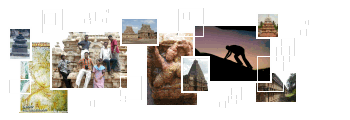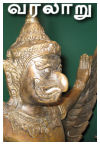 |
 |
 |
http://www.varalaaru.com A Monthly Web Magazine for South Asian History [187 Issues] [1839 Articles] |
 |
 |
 |
http://www.varalaaru.com A Monthly Web Magazine for South Asian History [187 Issues] [1839 Articles] |
|
Issue No. 87

இதழ் 87 [ மார்ச் 16 - ஏப்ரல் 15, 2012 ] 
இந்த இதழில்.. In this Issue.. 
|
Udirappatti means solatium or compensation given to the family of a person who committed sacrifice or murdered or committed suicide on false accusation. Three inscriptions mentioning udirappatti are found at rock cut temple complexes in Pudukkottai district. These inscriptions are found at Thevarmalai, Kudumiyanmalai and Thirumeyyam. The inscription at Thevarmalai1 is on the eastern slope of the hillock to the south of the rock cut shrine. It is partly defaced and about seventeen lines. The inscription dated 11th day of the month Avani in Thunmuki year, speaks about the compensation given to one Naadiyar daughter of Periyan alias Paraiyan of Peraiyur by the village assembly of Malayalangudi in Virudhurajabayangara valanadu of Kananadu. It further speaks that an offence related to temple affairs happened at Malayalangudi for which one Maluva Kumarappar died of consuming poison. For this the compensation consists of three Ma of land and a plot. Due to the defaced nature of the inscription it is unable to understand the relationship between Nadiyar and Maluva Kumarappar. The inscription also details the landmark of the allotted land and also refers Nathavana land, Ponnulagu land, Vevalapponnari land, Periyan land. The plot that was allotted to Naadiyar was to the south of the Thachchar plot in Melaichchiragu. Noted information of this inscription is Malayalangudi mentioned as a Padaiparru which means a military station. It is also understood that one Ponnan was uncle of the Naadiyar. The signatories of the deed on behalf of the Villagers were Manikkamperaiyan, Vanavatharaiyan, Samaya Manickapparaiyan. The udirappatti inscription of Thirumeyyam2 is found on the western wall of the mukha mandapa of the Senaimudaliyar shrine in the Sathyamoorth temple complex. The inscription dated 29th day of the month Adi in Vigari year, might belong to 17th century AD. It speaks about the murder of one Esandan by the Antharibattar group, who were the worshippers of the deity Korravai. The murder happened at Kadiyar vayal of Kananadu due to some previous enmity. The issue came to the knowledge of the two temple authorities of Thirumeyyam and also the assembly of Kananadu. The authorities assembled and gave their verdict after hearing the crime. As per the verdict the land pieces of the convicts were given as udirappatti to the son of the deceased, named one Makkayan. The authorities also decided that from the produce, a kalam of paddy from each ma had to be given to the temple. Names of the accused known through the inscription are Kaithottar alais Erumaibattan, Engumai Nindran etc. The compensated lands are Pandivalan vadakuru vayal, Manam Periyar vayal, Periyar vayakal. The udirappatti inscription of Kudumiyanmalai3 is found on the western wall of the Akilandeshwari shrine belongs to Maravarma Sundarapandya of AD 1233. This incomplete inscription speaks about the endowment of a land named Mukkulam vayal as devadana to the Thirunalakkunramudaiya nayanar by Kalikadintha Pandyadevar. It is mentioned that a loyal servant named Kaikolar Koothar chopped his head to construct a door way to the devadana land. For this sacrifice 2 ma of land was allotted to the relatives of Koothan as solatium. The compensation was ordered by the king and the royal order was sent to the temple trustees with the assent of the government official Kurukularayar. The mother of the deceased Koothan is Nachi. Thus these three inscriptions help us to understand the system of Judiciary prevailed in the Medieval Tamil society. These three inscriptions speak three different cases of loss of life viz., sacrifice, suicide and murder. Even though the nature of these cases varies, but the judgment was the same, that is, land compensation. For sacrifice and suicide the compensation was made from common property but for murder the compensation was made from the convicts. Judiciary was not a separate entity, Village Assemblies and Temple authorities play the role of Judiciary. Another interesting aspect to note is that even the criminal cases came under the judicature of the local authorities and also the punishments were merely confiscation of properties instead of capital in nature. Thus the modern concept of judiciary as a separate establishment, codified law, punishments like imprisonment, capital punishment, was not common. Hence it was not a well organized system instead it was much local in character in the lower units of administration. One of the interesting aspects relating to the inscription of Kudumiyanmalai is the decipherment of the terminology ‘Kftiz’ by Dr.R.Kalaikkovan4. As per him the statement in the Kudumiyanmalai inscription 'முக்குளத்து வயலின் திருவாசல் முகவணையெற தலையரிந்த கைக்கொளன்' indicates the sacrifice of one Kaikolan for constructing a doorway, but he was unable to understand the term 'முகவணை' what actually meant. It was an accidental discovery by him in our field study at Poovalaikkudi. One of the newly discovered inscription5 found on the lintel of the mukha mandapa eastern entrance at Poovalaikkudi rock cut cave has the usage of the same terminology. The inscription speaks that 'இந்த முகவணையுந் திருநிலைக் காலும் கோவனும் மறவரில்" by which he deciphered the term 'முகவணை' as the component lintel of the doorway. References : 1. IPS 927, SII 23 of 157. 2. வரலாறு 20, ஆய்விதழ், டாக்டர் மா.இராசமாணிக்கனார் வரலாற்றாய்வு மையம், திருச்சிராப்பள்ளி -18, ப.18-19. 3. வரலாறு 11, ஆய்விதழ், டாக்டர் மா.இராசமாணிக்கனார் வரலாற்றாய்வு மையம், திருச்சிராப்பள்ளி -18, ப.17. 4. Director, Dr. M.Rasamanickanar Centre for Historical Research, Tiruchirappalli - 18. 5. வரலாறு 21, ஆய்விதழ், டாக்டர் மா.இராசமாணிக்கனார் வரலாற்றாய்வு மையம், திருச்சிராப்பள்ளி -18, ப.25. Text of the Kudumiyanmalai Inscription : Place : Western wall of the Mahamandapa of Akilandeshwari Shrine. 1. அருளிச் செயல் திருநலக்குன்றமுடைய நாயனார் கோயில் தானத்தாற்கு இன் 2. நாயனாற்கு தேவதானமாக கலிகடிந்த பாண்டிய தேவன் குடுத்த முக்குளத்து வயலின் 3. திருவாசல் முகவணையேற தலையாpந்த கை;ககோளன் உடையநாச்சி மகன் கூத் 4. தன் உறவுமுறையாற்கு உதிரப்பட்டியாக இரண்டு மாச்செய் பதிநேழாவது முதல் 5. அனுபவிப்பதாக கல்லுவெட்டிக் குடுக்க இவை குருகுலராயனெழுத்து இந்த 6. முக்குளம் பெருமாளான காங்கேயர்க்கு காணி ஆக விற்றுக் குடுத்த 7. குறுமறை நாட்டு கேந்தனோpக் கை;ககோளாpல் பொன்னம்பலவன் உய்யவந்த Text of the Thirumeyyam Inscription : Place : Western wall outerside of the Mukha mandapa of the Senai Mudaliar Shrine. 1. விகாரி வருஷம் 2. ஆழ 29 உ 3. கானனாட்டு 4. கழயார் வய 5. லில் அந்தரி பட் 6. டர்கள் த';களி 7. ல் விரொதமா 8. யீசாண்டா 9. னைக் டிகால்லு 10. கையில் இரண் 11. டு கொயிலில் க 12. hணியஜம் கானனா 13. ட்டு நாட்டவரும் 14. வுழ கைத்டிதா 15. ட்டார் ஆன எரு 16. மை பட்டன் உ 17. ள்ளிட்டார் நில 18. மான பாண்ழயn 19. வளான் வடவுறு 20. நிலம் ஒருமாவஜம் 21. எ';குமாய் நின் 22. றான் நிலமான ம 23. னம் டிபரியர் வ 24. யக்கல் நிலம் முக்கா 25. ல் . . . டிகாண்டு நாயமாற்கு கல்லு 26. ம் ஊன்றி இந்த 27. நிலம் சிவலம் 28. சுப்பிறதீபம் உள்ளிட்டார் பாண் 29. ழ வெளான் வடவுறுநிலமும் யீ 30. சாண்டான் மகன் மாக்கயான் மனம் டிபரியர் 31. மாவஜக்கு கல டிநல்லு இறுத்து உ 32. திரப்பட்ழயாக சந்திராத்தவற் டிசல்ல அ 33. னுபவிக்க கடவாராகவஜம் இப்பழக்கு நாட்டுக் கணக்கு டிதன்னவதரைய 34. ன் எபுத்து. this is txt file� |

சிறப்பிதழ்கள் Special Issues 

புகைப்படத் தொகுப்பு Photo Gallery 
|
| (C) 2004, varalaaru.com. All articles are copyrighted to respective authors. Unauthorized reproduction of any article, image or audio/video contents published here, without the prior approval of the authors or varalaaru.com are strictly prohibited. | ||